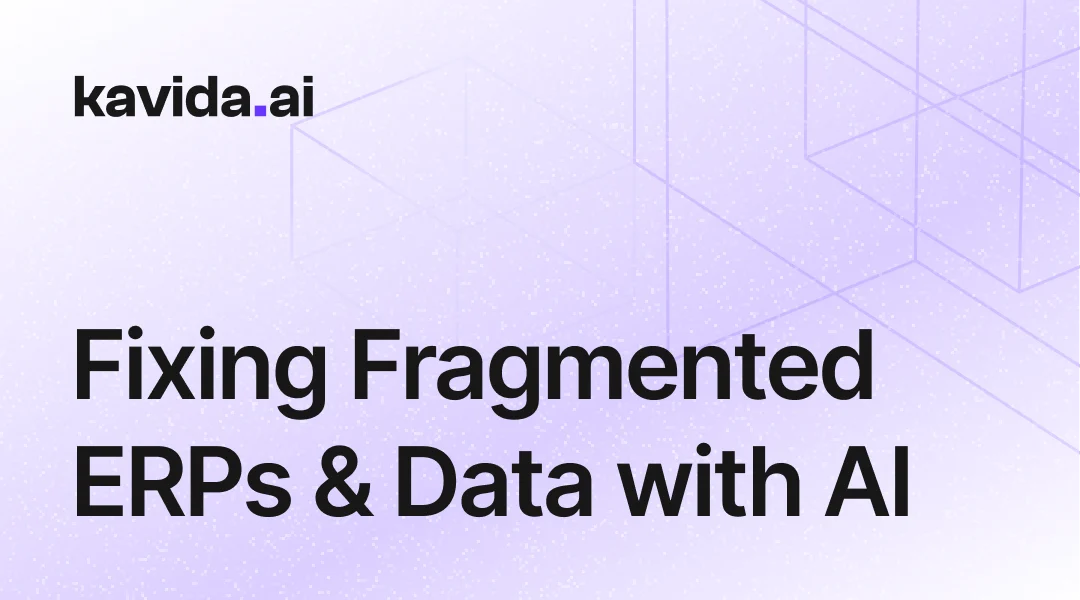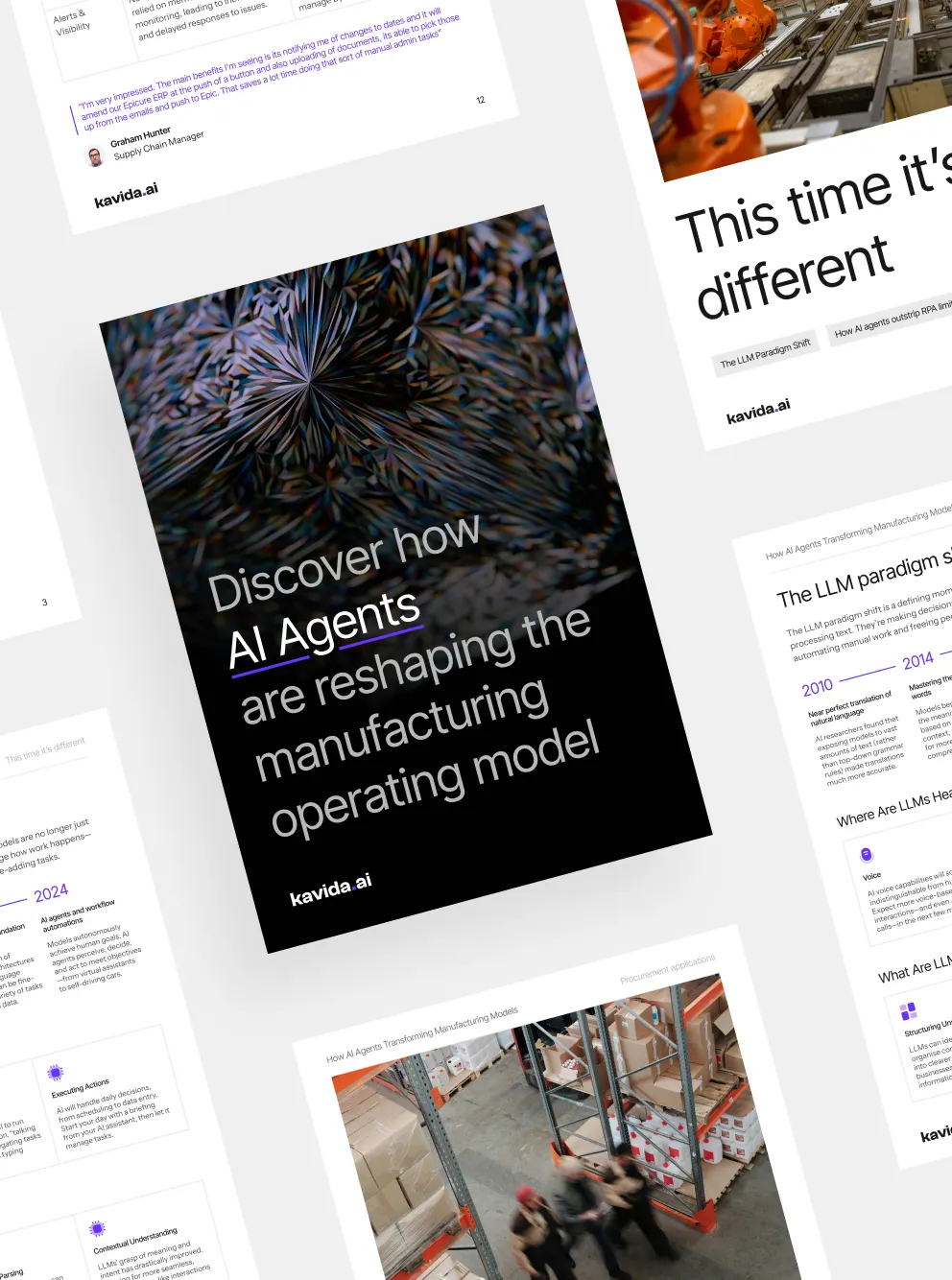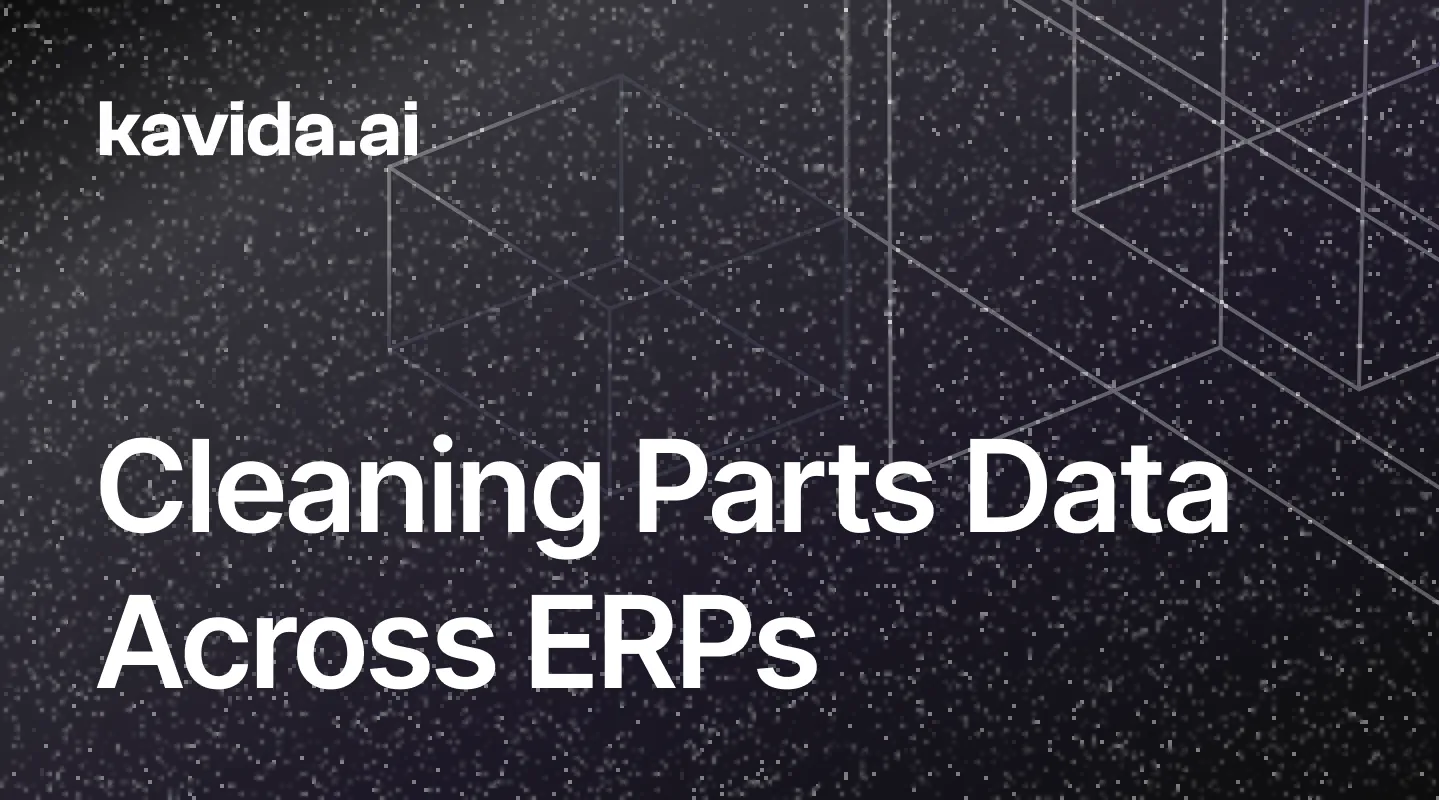

Discover how AI agents are reshaping the manufacturing operating model

Hi, I’m Alison!
Share your details, and I’ll give you a call in minutes to see how we can assist.

The Ultimate Guide to Procuring Generative AI for Your Manufacturing Company
Table of Contents
ToggleProcurement leaders today need more than just efficient workflows—they need insights that drive smart decision-making. For decision makers, leveraging real-time data and meaningful insights is the key to optimizing procurement operations, mitigating risks, and building resilient supply chains. By providing better data, better reports, and ultimately better decisions, Agent PO transforms procurement from a reactive function into a proactive, strategic powerhouse.
Building Data-Driven Procurement Process Through Decision Intelligence
Agent PO seamlessly integrates with data streams across procurement, production planning, finance, inventory management, and logistics. It gathers data from ERP systems, supplier communications, logistics platforms, and financial databases, including Purchase Orders (POs), invoices, shipment details, inventory levels, and supplier performance, to create a comprehensive view of procurement activities.
The system also utilizes natural language querying, allowing teams to access specific information in real time. Whether it’s checking the status of an order or requesting supplier performance metrics, Agent PO’s ability to extract meaningful data from various sources ensures that procurement leaders are always equipped with the information they need.
Turning Data into Actionable Insights
Collecting data is only the first step; transforming that data into actionable insights is where intelligent automation creates competitive advantage. By analyzing the collected data, AI infused ERPs provides teams visibility on an array of valuable metrics and insights. It calculates key performance indicators (KPIs) such as On-Time In-Full (OTIF) delivery, supplier responsiveness, and inventory turnover rates. These metrics are used to create reports that inform procurement leaders about their current operations, highlight inefficiencies, and help forecast future needs.”
It also helps identify risks by monitoring supplier stability, regulatory compliance, and geopolitical issues. This means procurement teams can proactively address risks before they escalate into major disruptions. Through its automation capabilities, Agent PO not only analyzes data but also continuously monitors procurement activities, ensuring that alerts and insights are always up to date.
Creating Visibility for Procurement Teams
Through its capability to extract data from multiple data platforms, Agent PO’ decision intelligence generates reports that give procurement teams a clear, data-driven view of activities, helping them make smarter decisions and drive efficiency.
- Supplier Scorecard Reports: Comprehensive evaluation of supplier performance across various metrics, such as OTIF, responsiveness, and order changes. Procurement teams can use these reports to manage supplier relationships more effectively and identify areas for improvement.
- Benefit: Strengthens supplier relationships, ensures accountability, and supports better negotiation outcomes.
- Benefit: Strengthens supplier relationships, ensures accountability, and supports better negotiation outcomes.
- Spend Visibility Reports: By aggregating spend data across suppliers, materials, and countries, Agent PO creates detailed spend visibility reports. These reports help procurement leaders track expenditures, optimize budgets, and identify cost-saving opportunities.
- Benefit: Improves budget control, identifies cost-saving opportunities, and drives more strategic spending.
- Benefit: Improves budget control, identifies cost-saving opportunities, and drives more strategic spending.
- Risk Assessment Reports: Agent PO continuously monitors suppliers for risks, such as financial instability or compliance breaches. These reports help procurement teams identify potential risks and take proactive steps to mitigate them.
- Benefit: Reduces the likelihood of supply chain disruptions and enhances business continuity.
- Benefit: Reduces the likelihood of supply chain disruptions and enhances business continuity.
- Inventory and Stock Reports: Reports on inventory turnover, stagnant inventory, and Weeks on Hand (WoH) metrics help procurement teams optimize inventory levels, reduce excess stock, and maintain the right balance of inventory to meet production needs.
- Benefit: Minimizes carrying costs, avoids stockouts, and improves cash flow.
- Benefit: Minimizes carrying costs, avoids stockouts, and improves cash flow.
- Forecast Accuracy Reports: By comparing forecasted demand with actual demand, these reports help procurement teams identify discrepancies and improve the accuracy of their forecasting models, leading to more efficient inventory and procurement planning.
- Benefit: Ensures better alignment between supply and demand, reduces excess inventory, and avoids stockouts.
- Benefit: Ensures better alignment between supply and demand, reduces excess inventory, and avoids stockouts.
- Order Revision and Delay Reports: These reports track any changes to POs and highlight delays in delivery schedules, allowing procurement leaders to take corrective measures in a timely manner.
- Benefit: Helps minimize disruptions, maintain production schedules, and improve supplier accountability.
Better Decisions with Better Reports
Through the detailed, data driven insights, the reports empower CPOs and Procurement Managers to make informed decisions that drive operational excellence.
Comprehensive Visibility into Procurement Activities: Agent PO collects data from multiple systems, creating a centralized and unified view of procurement activities. By aggregating data related to Purchase Orders (POs), supplier performance, spend analytics, inventory levels, and more, procurement teams can gain comprehensive visibility into their operations.
- Identify inefficiencies across the procurement process, such as excessive lead times or discrepancies in supplier performance.
- Optimize inventory levels by understanding inventory turnover, slow-moving stock, and inventory requirements.
2. Data-Driven Supplier Management: Agent PO’s reports provide detailed insights into supplier performance, including metrics such as On-Time In-Full (OTIF) delivery, changes to orders, responsiveness, and risk assessments.
- Evaluate Supplier Performance: The Supplier Scorecard allows them to assess suppliers on various criteria like OTIF, responsiveness, order changes, and risks, helping identify underperforming suppliers and fostering performance improvement initiatives.
- Improve Supplier Relationships: By identifying which suppliers are consistently delivering on time and meeting expectations, CPOs can strengthen relationships with reliable suppliers, negotiate better terms, and consolidate supplier bases.
- Mitigate Supplier Risks: Real-time alerts about supplier risks (financial instability, geopolitical issues, compliance problems) enable Heads of Procurement to proactively manage risks and make informed decisions to safeguard supply chain stability.
3. Optimizing Spend and Reducing Costs: With reports such as the Supplier/Material/Country Spend Report, CPOs can get a detailed breakdown of procurement expenditures across suppliers, materials, and geographies.
- Identify Cost-Saving Opportunities: By understanding spending patterns, they can identify opportunities for consolidating purchases, negotiating volume discounts, and reducing sourcing costs.
- Manage Supplier Agreements: Insights into supplier pricing trends and benchmarking help in negotiating better terms with suppliers, reducing procurement costs, and optimizing sourcing strategies.
- Monitor and Control Budgets: Real-time spend visibility helps CPOs manage budgets more effectively, ensuring spending aligns with organizational goals.
4. Improving Procurement Efficiency Through Automation: Agent PO automates workflows like chasing missing documents, confirming orders, and monitoring PO delays.
- Free Up Time for Strategic Initiatives: Automating routine and repetitive tasks helps reduce manual effort, allowing them to focus on higher-value activities, such as strategic sourcing, supplier development, and cost optimization.
- Reduce Human Error: Automation minimizes the likelihood of errors in processes like document matching, order confirmations, and follow-ups. Accurate data leads to better decision-making and fewer disruptions in procurement activities.
5. Proactive Risk Management: Agent PO collects data related to various risk factors and provides comprehensive risk assessment reports. This data-driven risk management approach helps:
- Anticipate and Manage Supplier Risks: Alerts related to supplier financial stability, compliance issues, or geopolitical risks allow them to mitigate risks before they escalate into major disruptions.
- Make Strategic Sourcing Decisions: Real-time data on supplier risks helps in diversifying the supplier base, finding alternative suppliers, and ensuring business continuity.
- Manage Work Order Risks: Reports on material shortages or supply chain issues affecting work orders enable procurement leaders to proactively address risks that might impact production timelines.
6. Strategic Decision-Making with Real-Time Insights: Agent PO provides real-time data insights
and interactive query capabilities, procurement heads to get instant answers to specific questions.
- Adapt to Changes Quickly: Alerts about stockouts, PO delays, shipment status, or delivery issues allow them to respond quickly, avoiding disruptions and improving procurement efficiency.
- Make Informed Decisions: With interactive querying, they can get answers to questions like “What is the status of supplier X’s performance?” or “What are the current inventory levels?” This ability to access up-to-date information instantly leads to more informed and timely decision-making.
7. Strategic Inventory Management: Agent PO provides insights into inventory levels, turnover rates, and stagnant inventory. It also:
- Optimizes Inventory Levels: Reports on stagnant inventory and Weeks on Hand (WoH) help them understand which items are moving slowly and which inventory levels need adjustment, allowing for better inventory planning and reduced carrying costs.
- Prevents Stockouts: Alerts for stockouts and new order placement help them maintain optimal inventory levels and avoid production disruptions, ensuring that materials are available when needed.
8. Forecasting and Planning: Accurate demand forecasting is crucial for procurement. Agent PO’s Forecast Accuracy Report helps with:
- Refining Demand Forecasts: By comparing forecasted versus actual demand and identifying discrepancies, procurement leaders can improve the accuracy of demand planning, reducing excess inventory and avoiding stockouts.
- Adapting Procurement Strategies: Reports that highlight the root causes of forecast errors (such as market shifts or supplier delays) provide valuable insights to adapt procurement strategies and align them with changing market conditions.
Better decisions start with better data. Agent PO collects data from multiple streams, transforms it into actionable insights, and generates detailed reports that help procurement leaders excel. With automated workflows, real-time alerts, and data-driven reports, CPOs and Procurement Managers can make informed decisions to enhance supplier performance, optimize spending, mitigate risks, and streamline operations. Agent PO turns data into a strategic asset, helping procurement teams thrive.
The Ultimate Guide to Procuring Generative AI for Your Manufacturing Company
Table of Contents
Toggle
Author:

Kevin Musprett
Head of Growth at Kavida.ai
Kevin drives GTM at Kavida, an AI agent used by manufacturing purchasing teams so they never miss a critical order from suppliers. Kevin dedicates himself to building and scaling kavida.ai to become the PO management platform of choice for an addressable market of over 15 million users.
Related articles

The ERP Migration Myth: How Agentic AI Unblocks Value Across Fragmented Systems
Procurement leaders today need more than just efficient workflows—they need insights that drive smart decision-making. For decision makers...

Cleaning and Consolidating Parts Data Across ERPs with AI Agents
Procurement leaders today need more than just efficient workflows—they need insights that drive smart decision-making. For decision makers...

AI Intimacy: How Supply Chain Agents Adapt to You
Procurement leaders today need more than just efficient workflows—they need insights that drive smart decision-making. For decision makers...
